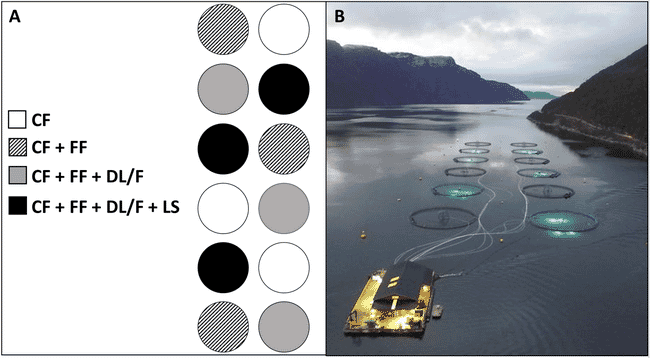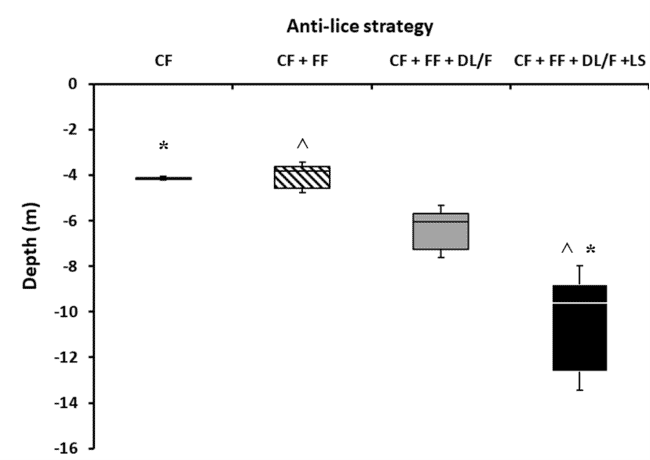In an experiment at the Centre for Aquaculture Competence, a full-scale research salmon farm in Norway, scientists tested if lice consumption by wild-caught corkwing wrasse changed when they were used together with a range of other measures to prevent lice.

© Gentry et al, 2020
The four anti-lice strategies were:
- Corkwing wrasse
- Corkwing wrasse and functional feed
- Corkwing wrasse, functional feed, and deep lights and feeding
- Corkwing wrasse, functional feed, deep lights and feeding, and lice skirts
The lice prevention strategies work in different ways. Functional feeds try to boost salmon immunity to better prevent infestation, deep feeding and deep lights try to entice salmon to swim deeper to avoid the surface waters where infectious salmon lice are most common, and lice skirts screen off the top 10m of the cage to prevent lice in surface waters from entering the cage and infecting salmon.
Wrasse were sampled from three cages of each anti-lice strategy three times over two months. Lice levels on salmon were recorded every three to four weeks. Across all the sea cages, only 11 percent of the wrasse ate lice.
“There were 10 times more salmon compared to cleaner wrasse, and most salmon carried lice, so the cleaners had opportunity to eat lice,” said lead author, Katharine Gentry, from the University of Melbourne.
‘”Lice skirts clearly reduced lice feeding, as the average lice consumption was one ninth that of standard cages containing only cleaner wrasse,” said Gentry.
A clue as to why this difference arose comes from the echo-sounders the researchers used to track the swimming depths of the salmon. While the salmon on average swam at shallow depths in other cages, they averaged a depth of around 10m in the cages with skirts (see figure below). If the cleaner fish stayed in the shallower waters their opportunities to eat the lice of salmon would have been reduced.

© Gentry et al, 2020
The scientists also tested if deep lights and deep feeding or functional feed affected cleaner fish efficacy but found that these groups performed similarly to cleaner fish without exposure to lice prevention strategies. Cleaner fish condition and welfare was also measured, with no major differences apparent across groups.
Industry implications
“This species of cleaner fish did not perform well when used with skirts at the site we investigated across a two-month period. But there are five different species of cleaner fish used in diverse environmental conditions where results could differ,” explains co-author Samantha Bui, from the Institute of Marine Research. “Cleaner fish might be effective in skirts in other circumstances.
“The results of this study highlight the need to rigorously test cleaner fish use in full-scale settings to work out when they work well, and when they don’t, so that farmers can quickly learn and implement best practices,” added Bui. “Lice control in the industry is dynamic and strategies can change rapidly as new techniques and technologies come onto the market. When they arise, we need to test what they mean for cleaner fish”.
The study, which can be accessed here, was recently published in Aquaculture Environment Interactions under the title “Sea lice prevention strategies affect cleaner fish delousing efficacy in commercial Atlantic salmon sea cages”.



